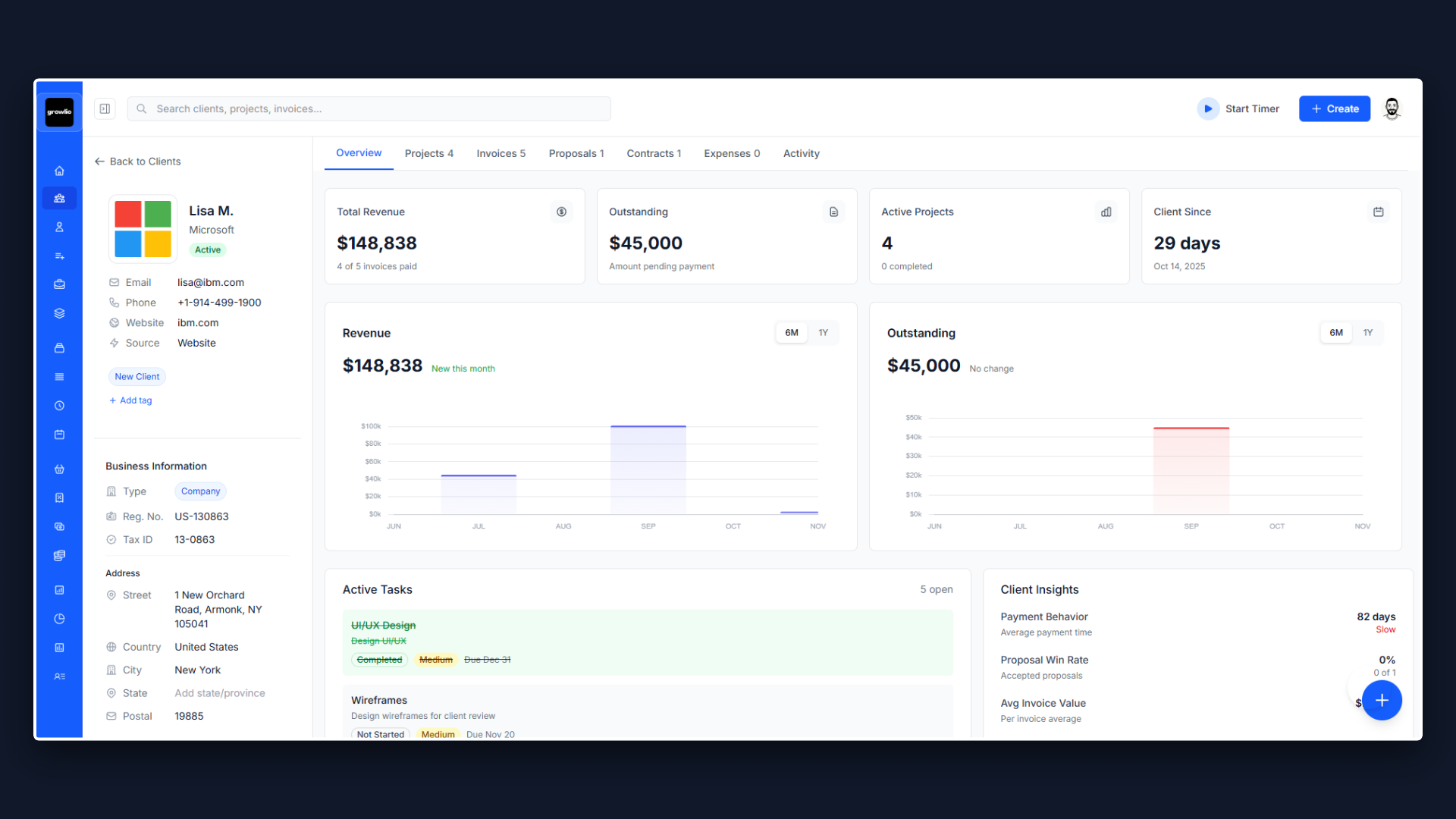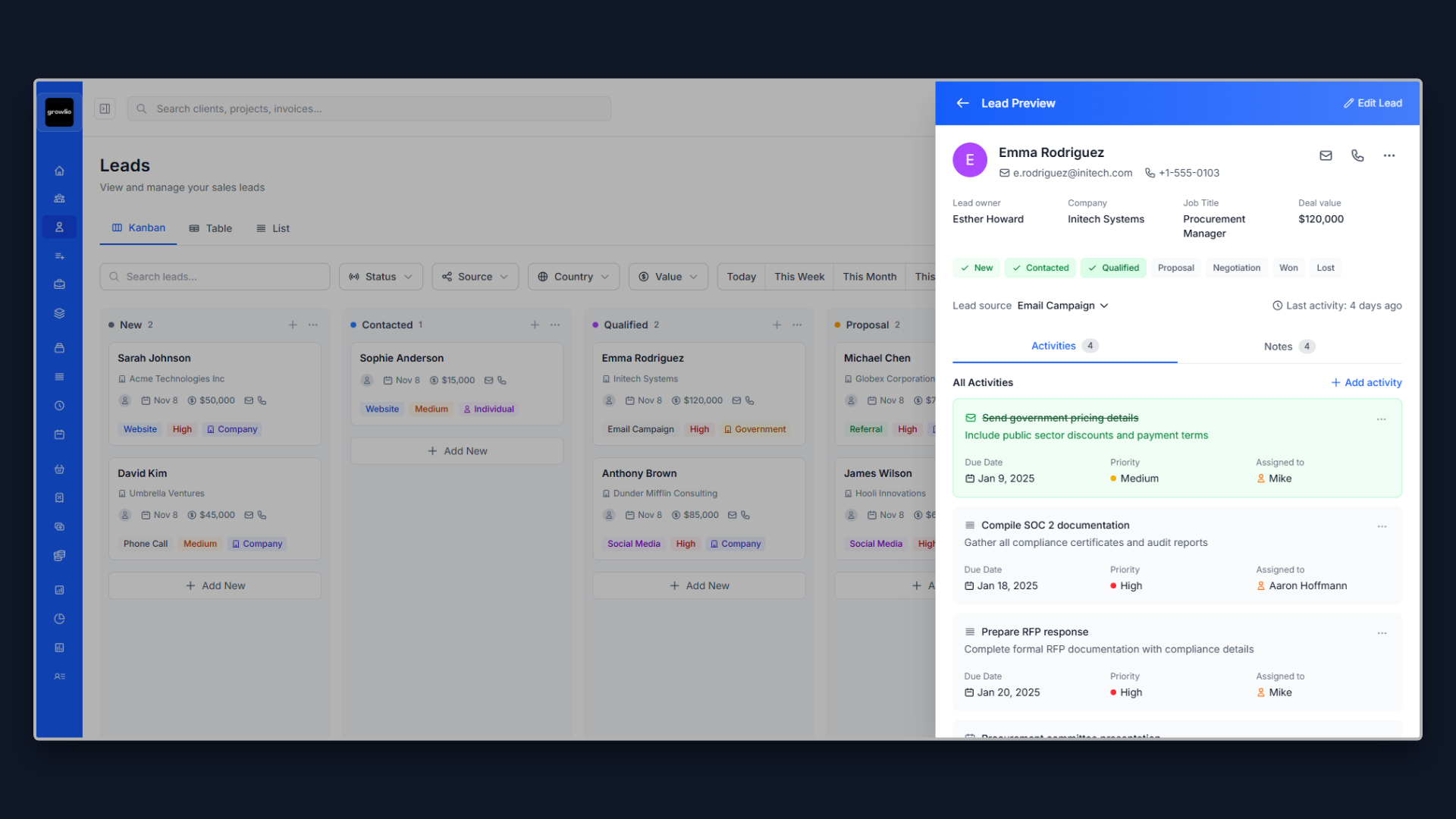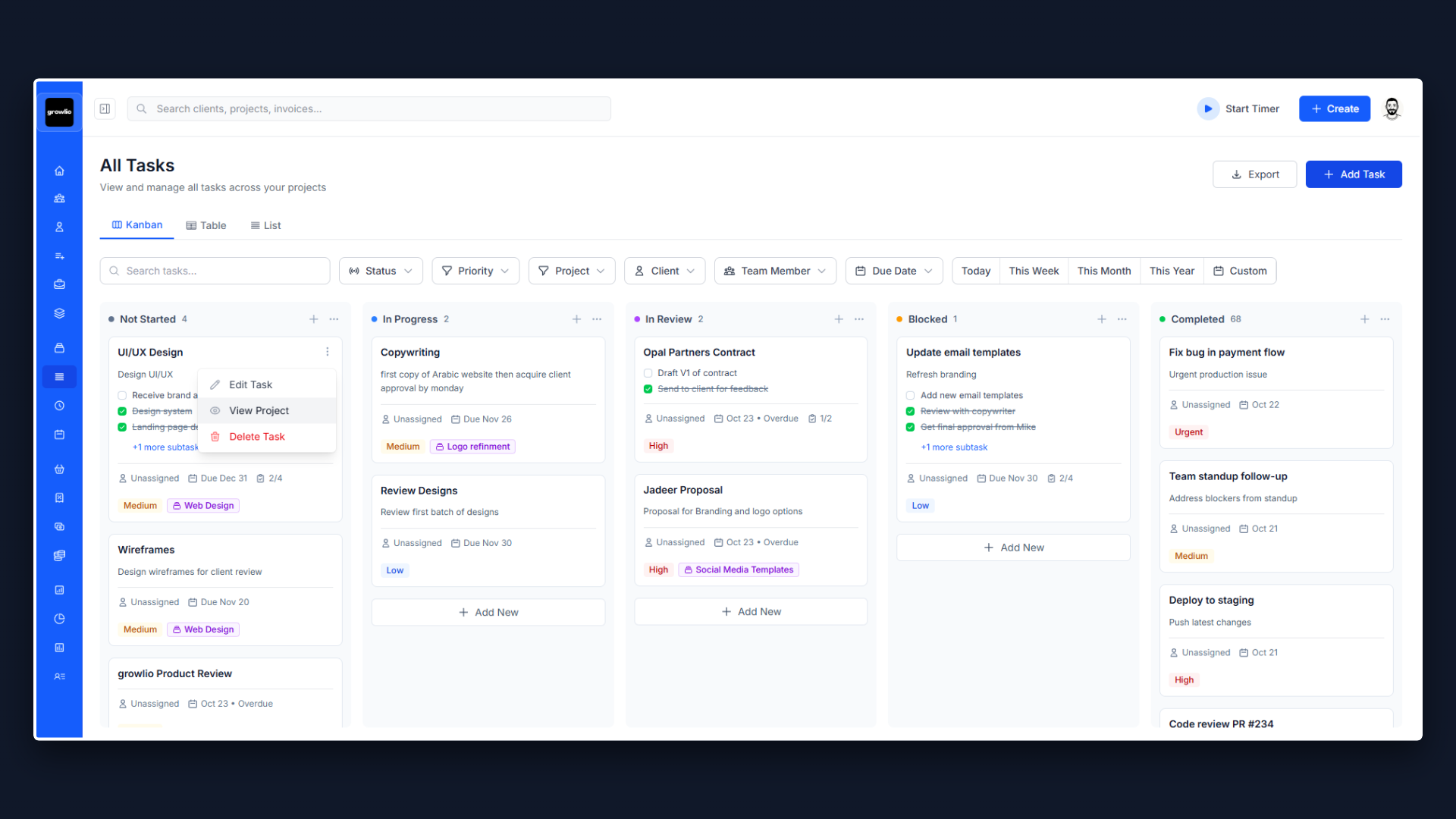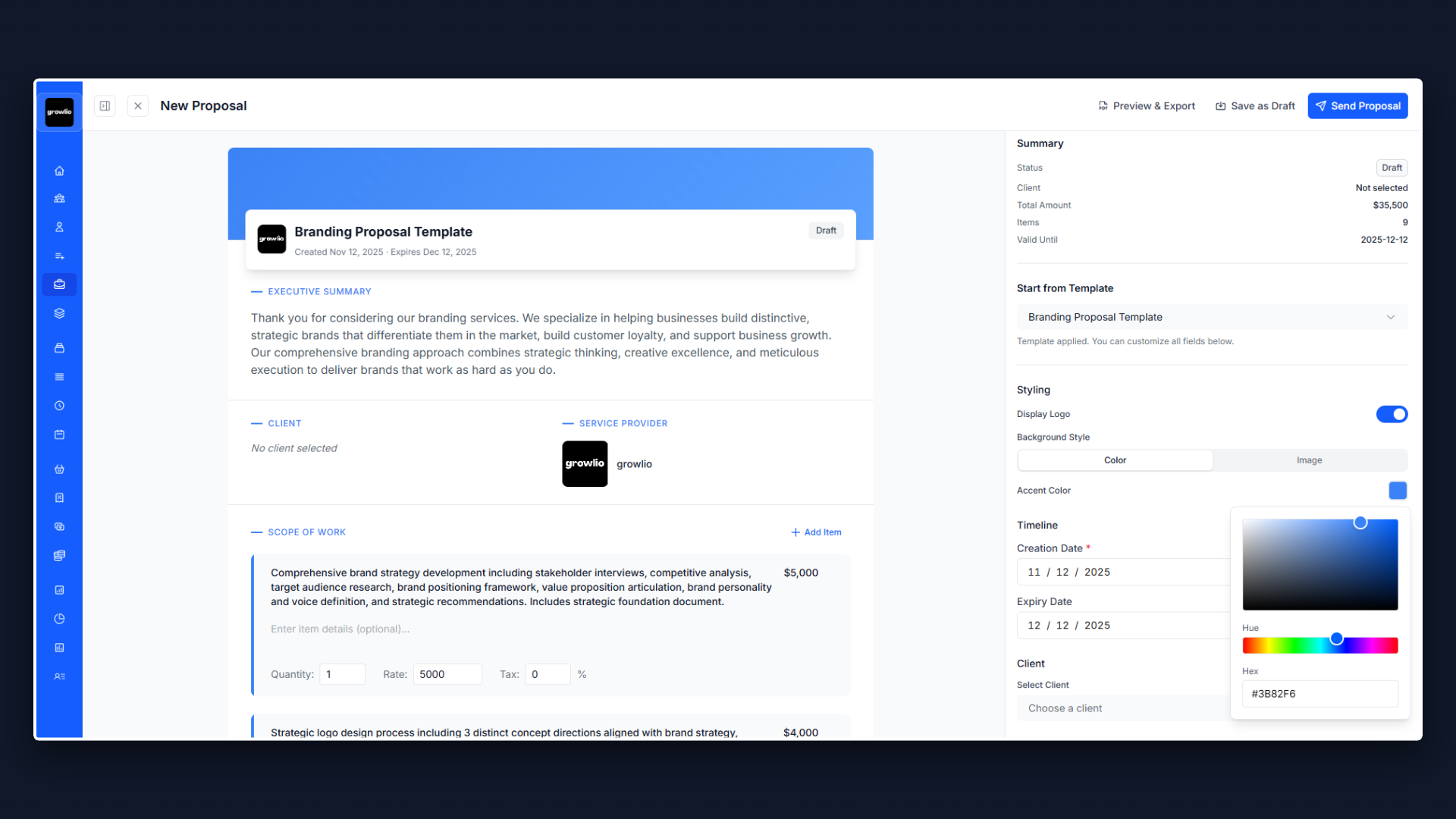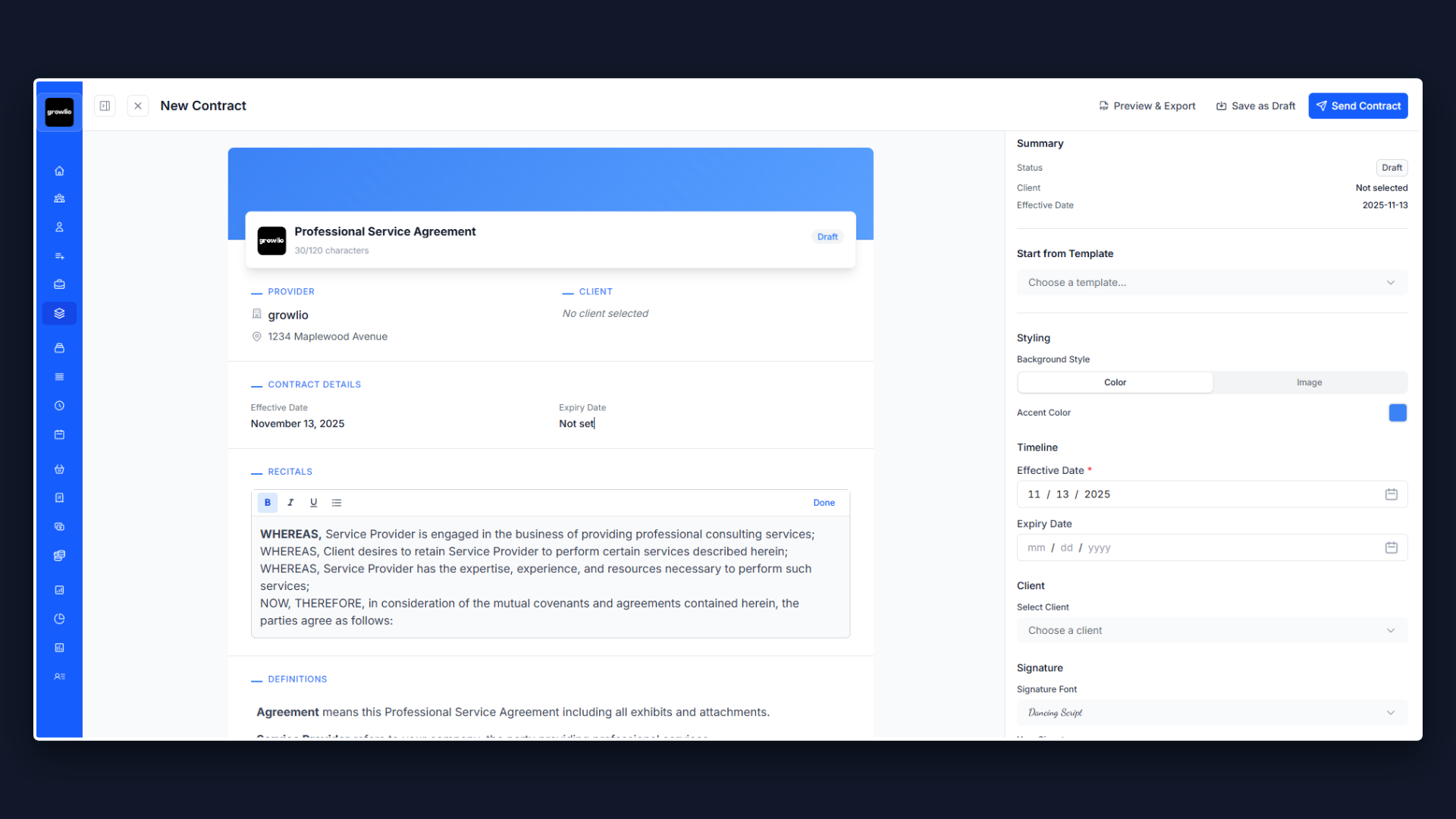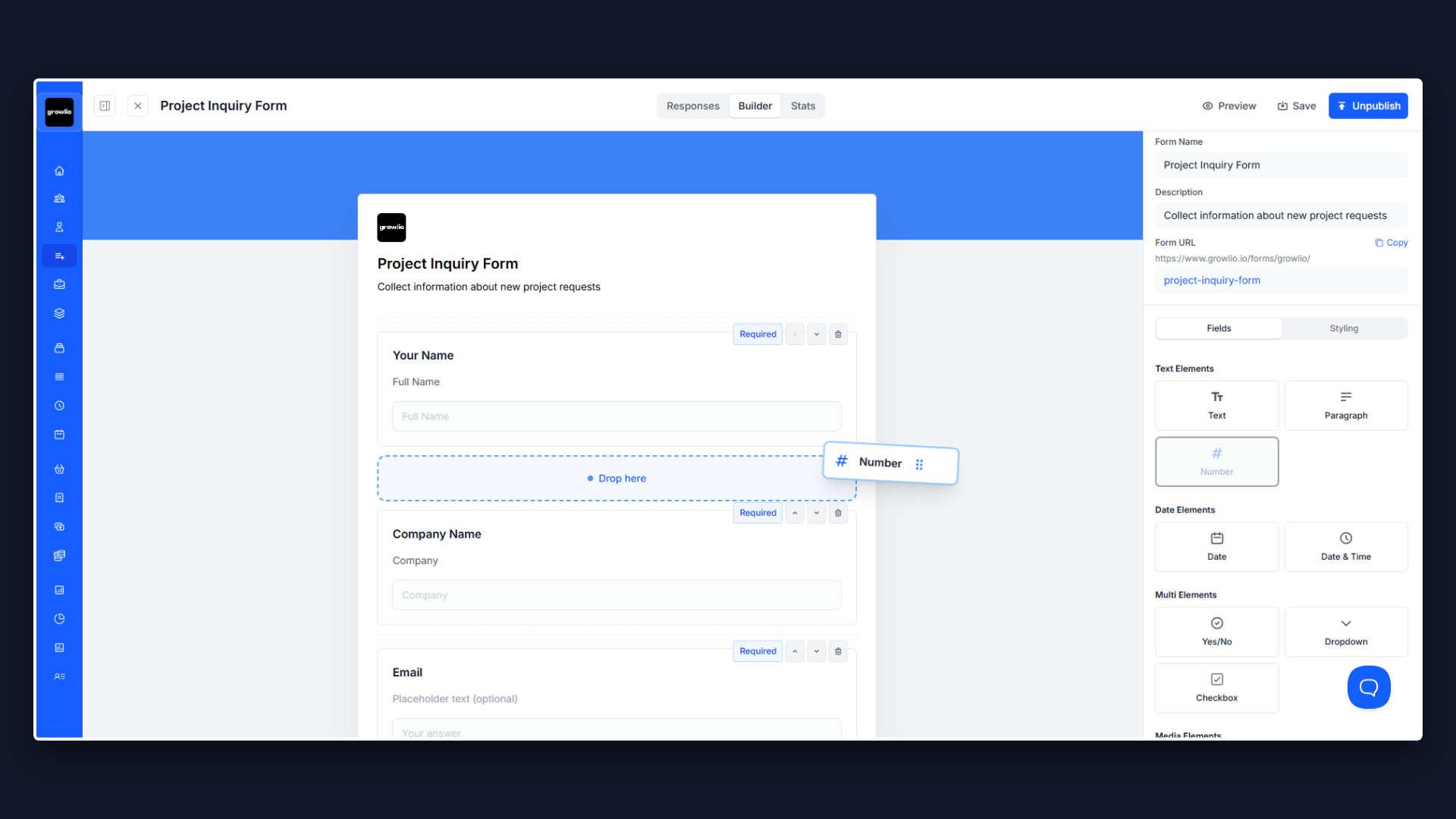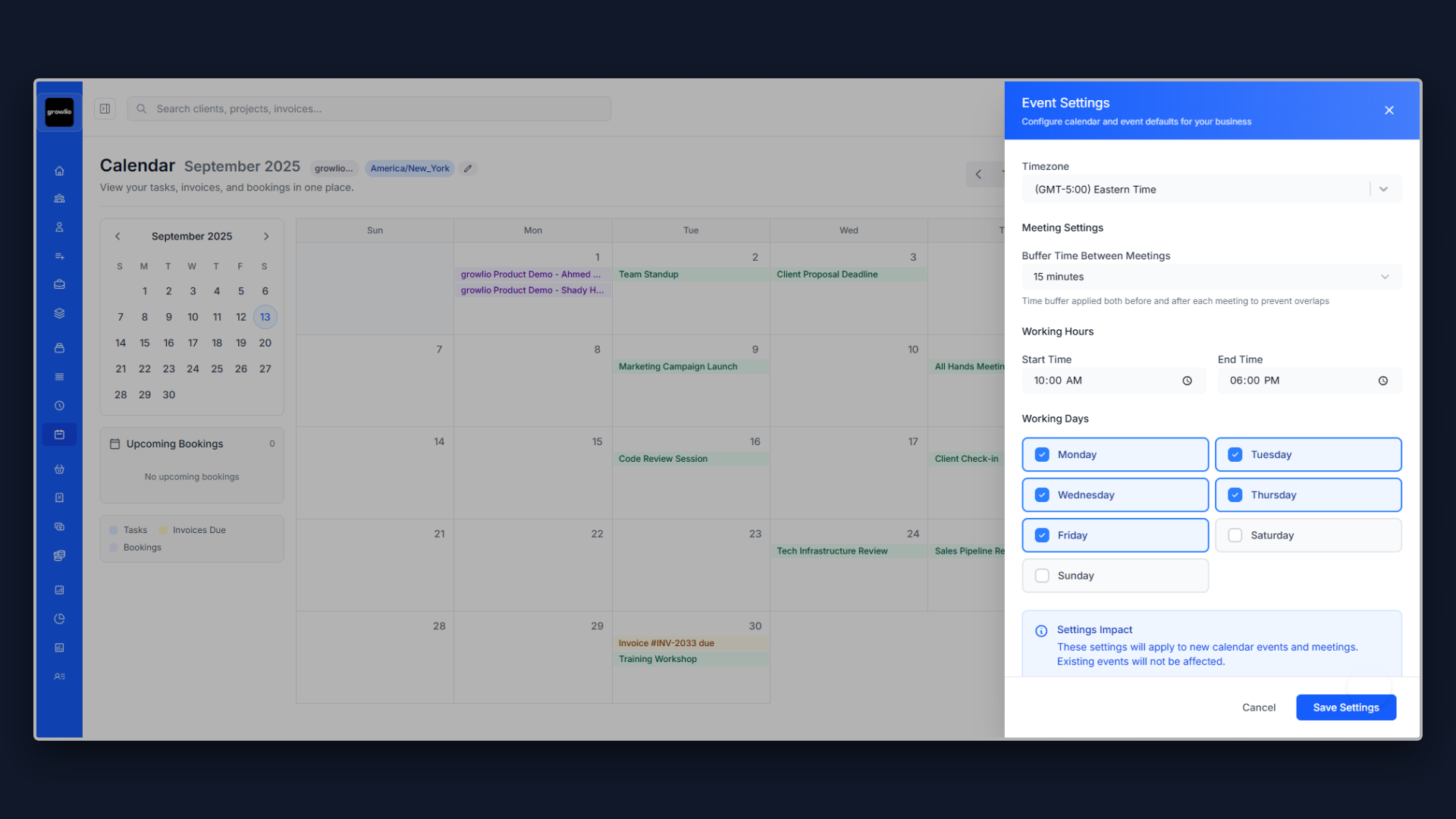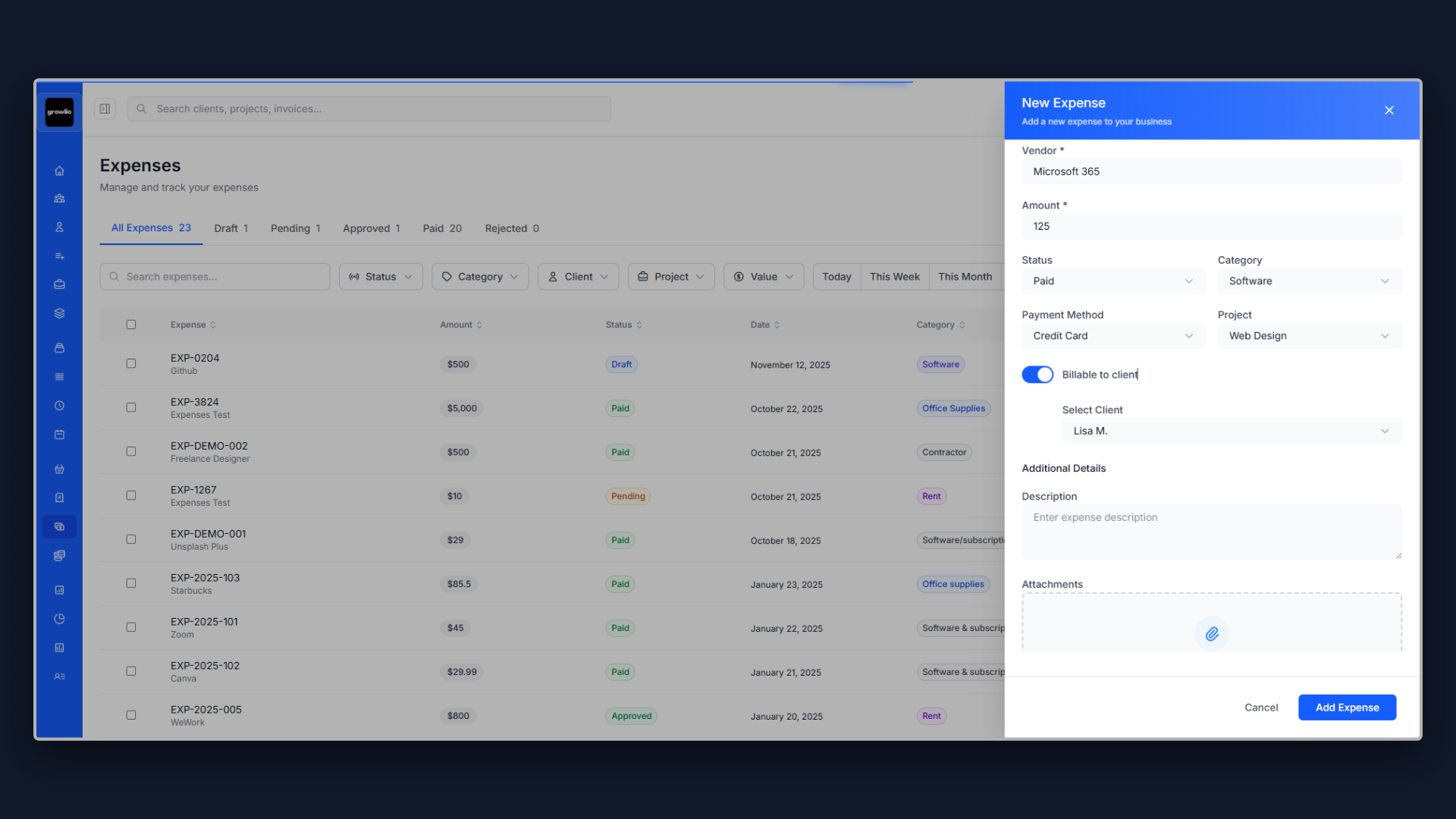Why Your Branding Proposal Makes or Breaks Your Business
As a branding consultant or design agency, you know that consistent brand presentation increases revenue by an average of 23%, and brands with strong identities command price premiums of 20% or more. But here's the harsh reality: even if you're exceptional at creating beautiful logos and cohesive visual identities, you'll struggle to win clients if your proposals don't demonstrate your value clearly.
The branding and design industry generates over $50 billion annually, with 77% of B2B marketing leaders saying branding is critical to growth and 89% of shoppers staying loyal to brands that share their values. Yet many talented brand designers lose projects to competitors who simply write better proposals. This has nothing to do with your design skills and everything to do with how you present them.
Your branding proposal is your first impression, your sales pitch, and your contract all rolled into one document. It needs to educate prospects who may not understand the difference between a logo and a brand while simultaneously proving you're the expert they need. This is a delicate balance that many get wrong.
1. Start With the Client's Current Brand Challenges, Not Your Services
The biggest mistake branding professionals make is leading with a list of services: "We offer logo design, brand guidelines, color palettes..." Your prospect doesn't care about your services yet. They care about their problems.
Start your proposal by demonstrating you understand their specific branding situation. Is their visual identity outdated and inconsistent? Are they struggling to differentiate from competitors? Do they lack clarity on what their brand stands for? Are they appealing to the wrong audience? Is their brand messaging confusing or generic? Address these pain points explicitly.
For example: "Our analysis shows your brand currently lacks visual consistency—your website uses three different logo variations, four different fonts, and no consistent color palette. Your marketing materials don't feel cohesive, making it difficult for customers to recognize and remember your brand. Meanwhile, your top competitors have strong, distinctive brand identities that command 15-25% price premiums in your market. A strategic rebrand focused on differentiation and consistency could position you as the premium choice in your category, potentially increasing both customer acquisition and average deal size by 20-30%."
This approach immediately shows you've done your homework and understand what's at stake. Now they're ready to hear your solution.
2. Include a Brand Audit to Demonstrate Your Expertise
Nothing builds credibility faster than showing you've already analyzed their brand. Include a brief audit section in your proposal highlighting 3-5 critical issues you discovered:
Visual Identity Inconsistencies: Multiple logo variations used inconsistently across channels, no defined color palette (random colors used throughout materials), 5+ different fonts across website and marketing assets, outdated or amateurish visual style that doesn't reflect brand positioning.
Brand Strategy Gaps: No clear brand positioning or unique value proposition, messaging that could apply to any competitor (generic and undifferentiated), unclear target audience (trying to appeal to everyone), missing brand personality and voice guidelines, no articulated brand values or mission that resonates emotionally.
Market Positioning Issues: Brand doesn't reflect current market position or premium pricing, visual identity appeals to wrong demographic or psychographic, brand feels dated compared to modern competitors, failing to communicate expertise and credibility effectively.
Customer Perception Problems: Brand creates confusion about what you do or who you serve, doesn't build trust or emotional connection, fails to differentiate from competitors in meaningful ways, inconsistent brand experience across touchpoints (website, social, sales materials, product/service delivery).
This mini audit serves multiple purposes: it proves you know what you're doing, it creates urgency by highlighting problems, and it makes your proposed solutions feel essential rather than optional.
3. Break Down Your Branding Process Into Clear Phases
Branding is complex and nuanced, but your proposal shouldn't be confusing. Break your process into clear, logical phases that clients can understand.
Phase 1: Brand Strategy & Discovery (Week 1-2)
Stakeholder interviews and customer research, competitive analysis and market positioning, target audience definition and persona development, brand positioning strategy and differentiation, core values, mission, and vision articulation, brand personality and voice framework, messaging platform and key narratives.
Phase 2: Visual Identity Development (Week 2-4)
Mood boards and creative direction exploration, logo design with 3 distinct concept directions, logo refinement and finalization, color palette development (primary and secondary colors), typography system (fonts for various applications), visual identity system and graphic elements, icon set and supporting graphics.
Phase 3: Brand Applications (Week 4-6)
Business card and stationery design, digital brand assets (social media templates, email signatures), marketing collateral templates (one-pagers, presentations), website design direction and guidelines, packaging design (if applicable), environmental graphics or signage concepts.
Phase 4: Brand Guidelines & Rollout (Week 6-8)
Comprehensive brand guidelines document, usage rules and application examples, brand messaging and voice guidelines, asset library with all brand files, internal brand training and presentation, brand rollout strategy and timeline.
This phased approach makes branding feel manageable and shows you have a clear roadmap. It also allows you to break pricing into phases if needed, making the investment feel less overwhelming.
4. Set Realistic Expectations About Timeline and Impact
One of the fastest ways to lose trust is overpromising results. Clients appreciate honesty about branding timelines and the nature of brand impact.
Be explicit: "Brand development is a strategic process that requires research, creative exploration, and refinement. A comprehensive brand identity typically takes 6-12 weeks from kickoff to final delivery, depending on scope and revision rounds. Brand impact—increased recognition, customer loyalty, and business growth—builds over time as the brand is consistently applied across all touchpoints."
Provide a realistic projection: "Based on typical branding engagements, you can expect: Weeks 1-2: Brand strategy foundation and creative direction established. Weeks 3-4: Logo concepts and initial visual identity presented for feedback. Weeks 5-6: Final logo and visual identity system completed. Weeks 7-8: Brand applications and comprehensive guidelines delivered. Months 3-6: As your new brand is consistently applied, expect improved brand recognition, stronger market positioning, and 15-30% increase in perceived value. Months 6-12: Full brand impact including customer loyalty improvements, ability to command premium pricing, and enhanced competitive differentiation."
These timelines may seem long to impatient clients, but they're realistic. Rush branding projects rarely deliver strategic value and often require expensive rebrands within a year or two.
5. Explain Your Brand Strategy Process
Many clients don't understand that branding is more than just design—it starts with strategy. Use your proposal to educate them on your strategic approach.
Explain that effective brand strategy involves: deep understanding of your business, market, and competitive landscape, clear definition of target audience (demographics, psychographics, behaviors, pain points), identification of your unique value proposition and differentiation, articulation of brand positioning (how you want to be perceived), definition of brand personality and voice (if your brand were a person, who would they be?), alignment of brand with business goals and growth strategy, and creation of emotional connection points with your ideal customers.
Outline your discovery process: "Brand strategy begins with discovery, not design. We conduct: stakeholder interviews to understand your vision and goals, customer interviews or surveys to understand perceptions and needs, competitive analysis to identify differentiation opportunities, market research to understand trends and positioning gaps, internal audit of current brand assets and messaging, and synthesis of findings into strategic recommendations."
Give specific examples: "Instead of starting with 'we need a new logo,' we start with 'who are you, what makes you different, and who are you speaking to?' This strategic foundation ensures your visual identity isn't just pretty—it's purposeful, differentiated, and aligned with business objectives."
This demonstrates strategic thinking and positions you above commodity logo designers.
6. Address Logo Design and Visual Identity Specifically
The logo is often what clients focus on, but it's only one element of brand identity. Educate them on the complete visual system.
Explain the logo design process: "We create logos that are: distinctive and memorable (standing out in your competitive set), versatile (working across all applications from tiny favicons to large signage), timeless (avoiding trendy elements that date quickly), appropriate for your industry and audience, and meaningful (connecting to your brand strategy and story)."
Outline your design approach: "You'll receive 3 distinct logo concept directions, each exploring different creative approaches aligned with your brand strategy. We present the strategic thinking behind each concept—not just pretty pictures, but design rationale. After your feedback, we refine your selected direction with 2-3 revision rounds to perfect every detail."
Address the complete visual identity: "A logo alone isn't a brand identity. We develop a complete visual system including: logo variations (primary, secondary, icon, monochrome), color palette (primary colors, secondary colors, tints and shades), typography system (headline fonts, body fonts, application guidelines), graphic elements and patterns, photography style and image guidance, iconography and illustration style, and layout principles and composition rules."
Set expectations: "Great logo design requires strategic thinking and creative exploration. We don't generate 50 random options—we create 3 strategic concepts thoughtfully developed from your brand strategy. Quality over quantity delivers better results."
7. Explain Your Brand Messaging and Voice Development
Brand identity includes verbal identity, not just visual. Many clients overlook this critical component.
Explain the importance: "Your brand voice—how you communicate across all touchpoints—is as important as your visual identity. Consistent, distinctive brand messaging differentiates you from competitors who may offer similar products or services."
Outline your messaging framework: "We develop comprehensive brand messaging including: brand positioning statement (how you want to be perceived), value proposition (why customers should choose you), key messages for different audiences and contexts, brand voice and tone guidelines (vocabulary, sentence structure, personality traits), messaging pillars (3-5 core themes that guide all communication), tagline or brand statement (if appropriate), and elevator pitch and boilerplate descriptions."
Provide examples: "Instead of generic messaging like 'We provide quality service,' we help you articulate specific, ownable messages like 'We turn complex regulatory challenges into competitive advantages for life sciences companies' (if that's your unique positioning). Specific, differentiated messaging attracts your ideal customers and repels poor fits."
Address consistency: "We create voice guidelines that ensure everyone in your organization—from salespeople to customer service to marketing—communicates with consistent personality and messaging. This consistency builds brand recognition and trust."
8. Include Brand Guidelines and Asset Delivery
Clients need to know exactly what they'll receive. Be specific about deliverables and how they'll be able to use their new brand.
Explain brand guidelines: "We create comprehensive brand guidelines (30-60 pages) serving as the rulebook for your brand. Guidelines include: logo usage rules and clearspace requirements, color specifications (CMYK, RGB, HEX, Pantone), typography specifications and pairing rules, imagery and photography style guidance, do's and don'ts with visual examples, application examples across various media, brand voice and messaging guidelines, and contact information for brand questions."
Outline asset delivery: "You'll receive all brand assets in formats you need: logo files (AI, EPS, PDF, SVG, PNG, JPG in various sizes), color swatches for design software, font files (with licensing), brand guideline PDF and printed book (optional), digital asset library organized by category, template files for common applications, and source files for all designed materials."
Address brand training: "We don't just deliver files and disappear. We provide brand training including: presentation of final brand to your team explaining the strategy and rationale, walkthrough of brand guidelines and how to use them, Q&A session addressing implementation questions, and ongoing support during initial rollout period (30-60 days)."
This thoroughness shows you're invested in successful brand implementation, not just pretty deliverables.
9. Explain Your Research and Competitive Analysis Approach
Strategic branding requires research. Show prospects how you differentiate from designers who skip this step.
Outline your research methodology: "Strategic branding begins with research, not assumptions. Our process includes: competitive visual audit (analyzing competitor brand identities to identify differentiation opportunities), market research and trend analysis, customer perception research (surveys, interviews, or focus groups), stakeholder interviews with leadership and team members, industry best practices and emerging trends, and target audience research (understanding demographics, psychographics, and emotional triggers)."
Explain how research informs design: "Research findings directly inform our creative direction. If competitors all use blue, we might explore warm colors for differentiation. If your target audience values innovation, we'll ensure your brand feels modern and forward-thinking. If customers perceive you as cold and corporate but you want to be approachable, we'll develop a friendlier visual and verbal identity."
Provide reassurance: "We don't create brands in a vacuum based on subjective design preferences. Every decision is rooted in strategic thinking informed by research. This approach delivers brands that work in the market, not just brands that look good in a portfolio."
10. Include Case Studies and Portfolio Examples
Nothing sells like examples. Include 2-3 relevant branding case studies in your proposal showing your work and results.
Format them simply: Client: B2B SaaS company in HR technology space. Challenge: Outdated brand that looked like legacy software, failing to attract modern buyers, losing deals to startups with sleeker brands. Strategy: Developed modern, sophisticated brand identity reflecting innovation and enterprise credibility, created complete visual system and messaging framework. Results: 40% increase in demo requests within 3 months, ability to raise prices by 18% without customer pushback, improved win rate against competitors, successfully raised Series B funding (investors cited brand transformation as evidence of market maturity).
Include portfolio pieces: "Please see the attached portfolio showcasing our branding work, including: [Brand Name 1]: Complete rebrand for [industry] company including logo, visual identity, and brand guidelines. [Brand Name 2]: Startup brand development from scratch including naming, visual identity, and messaging platform. [Brand Name 3]: Brand refresh and modernization maintaining equity while updating for current market."
If you're newer to branding and have limited client work, you can include: personal branding projects or self-initiated concept work, pro bono work for nonprofits or community organizations, branding from internships or previous employment, or spec work demonstrating your process and thinking.
Strong portfolio examples give prospects confidence in your abilities and help them envision their own brand transformation.
11. Transparent Pricing That Reflects Value
Branding pricing varies enormously by scope and expertise. However, vague pricing makes clients nervous and leads to scope creep.
Provide clear pricing tiers or packages: Starter Brand Package - $8,000: Brand strategy and positioning, logo design (3 concepts, 2 revision rounds), basic visual identity (colors, fonts), simplified brand guidelines (15-20 pages), core brand assets and file delivery. Complete Brand Package - $18,000: Everything in Starter, plus comprehensive brand strategy with research, extended logo exploration and refinement, complete visual identity system with graphic elements, comprehensive brand guidelines (40-60 pages), brand messaging and voice framework, brand applications (business cards, templates), brand training presentation. Premium Brand Package - $35,000: Everything in Complete, plus extensive market research and competitive analysis, customer research (surveys or interviews), naming or brand architecture (if needed), comprehensive brand applications across all touchpoints, website design direction and templates, brand launch strategy and internal rollout plan, 90-day post-launch support and consultation.
This tiered approach gives clients options and helps them see the value at each level. Be clear about what's included and what requires additional investment.
12. Make Next Steps Crystal Clear
Don't leave your prospect wondering what happens next. End your proposal with a clear call to action and process.
"Ready to build a brand that commands attention and premium pricing in your market? Here's how we get started: Step 1: Sign the proposal and return it by [date] with 50% deposit. Step 2: We'll schedule a kickoff workshop within one week to begin discovery. Step 3: Brand strategy and creative direction presented within 2-3 weeks. Step 4: Complete brand identity delivered within 6-8 weeks (timeline may vary by package). Questions? Schedule a call with me at [calendar link] or reply to this email."
This removes friction and makes it easy for prospects to say yes. The clearer you make the path forward, the more likely they are to take it.
Final Thoughts on Branding Proposals
Your branding proposal isn't just a formality—it's a sales tool, an educational resource, and a trust-building document. The brand designers who win the most clients aren't always the most talented creatives; they're the ones who best explain branding strategy in a way that makes sense to business owners.
Take the time to customize each proposal for your prospect. Reference their specific brand challenges, competitive landscape, and market positioning. Show that you've done the research. Demonstrate your expertise through a brand audit and strong portfolio examples. Set realistic expectations about timeline and impact. And make it easy to say yes.
Remember: a great branding proposal proves you understand their business and market, demonstrates you have a strategic process (not just design skills), shows evidence you can deliver distinctive, effective brands, and makes the investment feel worthwhile. Get these elements right, and you'll close more deals—even if your competitors have bigger portfolios or charge less.
